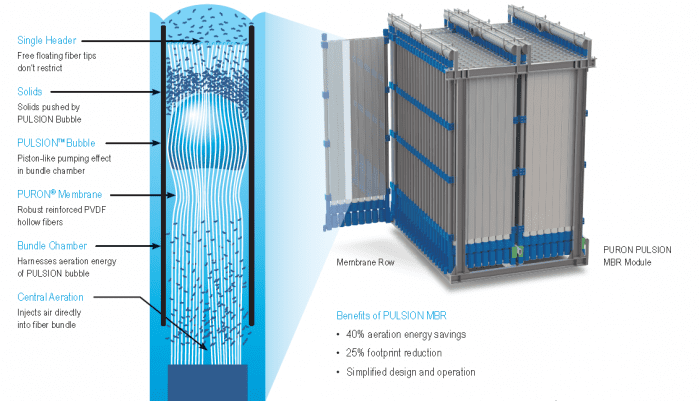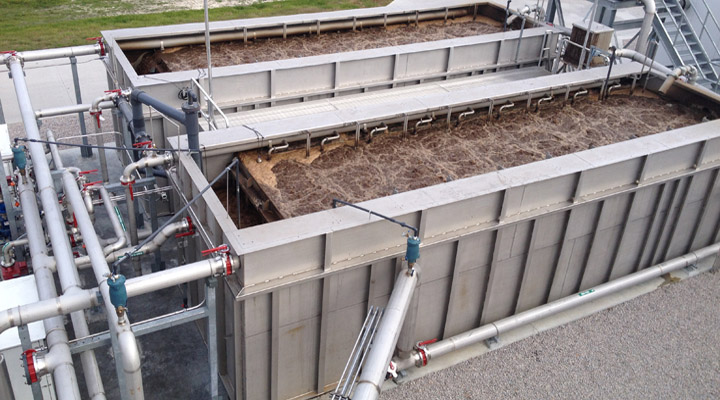Exploring the Environmental Impact of Membrane Bioreactor in Wastewater Treatment
Exactly How Membrane Layer Bioreactors Are Reinventing Water Filtration Systems
The development of membrane bioreactors (MBRs) stands for a significant advancement in the field of water purification, combining biological treatment procedures with innovative membrane filtration innovations. This integration not only improves the high quality of dealt with effluent yet also addresses metropolitan room restrictions, making MBRs especially ideal for largely populated areas. As international water deficiency heightens, the function of MBRs in promoting safe and clean water reuse and sustainable water administration comes to be progressively essential. Yet, the effects of this modern technology prolong beyond performance-- what obstacles and opportunities exist in advance for its widespread implementation?
Review of Membrane Bioreactors
Membrane layer bioreactors (MBRs) stand for a considerable innovation in water filtration innovation, as they integrate biological therapy procedures with membrane filtration. This combination boosts the efficiency of wastewater treatment by making use of microorganisms to break down organic toxins while at the same time utilizing semi-permeable membrane layers to different treated water from suspended solids and microorganisms.
The MBR system commonly is composed of an organic reactor where the microbial populace metabolizes contaminants, complied with by a membrane layer filtration unit that keeps biomass and enables only tidy water to travel through. This dual capability leads to higher effluent quality compared to conventional treatment methods. MBRs can be run in both set and continual circulation modes, providing flexibility in style and application.
They additionally enable the healing of water for reuse, thus contributing to water sustainability campaigns. On the whole, MBRs are at the center of enhancing water treatment efficiency and high quality, showcasing the capacity for cutting-edge solutions in ecological monitoring.
Advantages of MBR Modern Technology
The combination of organic treatment with membrane filtering provides countless benefits for water purification procedures. Among the key advantages of Membrane layer Bioreactor (MBR) modern technology is its capability to successfully eliminate both organic and inorganic contaminants, leading to high-grade effluent. The membrane layers serve as a physical obstacle, stopping suspended solids and virus from passing through, which enhances the total safety and dependability of cured water.
In addition, MBR systems call for a smaller footprint contrasted to conventional therapy techniques, permitting a lot more efficient area use. This small layout is specifically useful in metropolitan settings where land is restricted. MBRs also show functional versatility, suiting varying influent top qualities and circulation prices without significant performance destruction.
Additionally, the procedure supplies boosted nutrient removal capabilities, particularly for nitrogen and phosphorus, which are important for stopping eutrophication in getting waters. The lowered sludge manufacturing related to MBR innovation likewise translates to lower disposal prices, making it an economical service in the future - Membrane Bioreactor. In general, the benefits of MBR technology placement it as a leading choice for ingenious and sustainable water filtration systems, dealing with both ecological and economic issues
Applications in Water Filtration
Applications of Membrane Bioreactor (MBR) technology in water filtration are impactful and varied, dealing with different treatment needs throughout several markets. MBRs effectively combine organic treatment processes with membrane filtration, making them perfect for community wastewater therapy, commercial effluent monitoring, and even potable water reuse efforts.
In community settings, MBRs are progressively utilized to enhance the top quality of treated wastewater, permitting conformity with stringent discharge guidelines and assisting in the recycling of water for irrigation and non-potable uses. Their small design additionally makes them appropriate for metropolitan settings where space is restricted.
Industrially, MBR innovation is made use of to deal with process water and wastewater, specifically in fields such as food and drink, pharmaceuticals, and fabrics. By effectively removing pollutants click here for more and put on hold solids, MBRs assist industries reduce environmental effects while recouping valuable sources from wastewater streams.
Additionally, MBRs are getting traction in decentralized water treatment applications, where small systems can be released in remote areas or creating areas. This versatility enables areas to achieve sustainable water management remedies, enhancing accessibility to tidy water while lowering reliance on standard treatment techniques.
Study and Success Stories

In one more instance, a fabric manufacturing facility in Bangladesh embraced MBR technology to resolve its wastewater challenges. The system reduced chemical oxygen need (COD) levels from 1,200 mg/L to much less than 100 mg/L, thus satisfying regulative standards and considerably minimizing environmental influence.
The College of Cape Town's MBR installment has actually proven efficient in treating greywater for non-potable reuse on university. This job not only conserves drinkable water yet likewise works as an educational model for lasting methods.
Moreover, a seafood processing plant in Norway made use of MBR innovation to treat effluents containing high levels of raw material, accomplishing over 90% contaminant elimination. These study emphasize MBR innovation's adaptability and its important role in boosting water high quality across diverse applications.
Future of Water Therapy Solutions
As international water deficiency and contamination difficulties magnify, ingenious water therapy solutions are ending up being increasingly vital to make sure lasting access to tidy water. The future of water treatment exists in the combination of innovative technologies that enhance the i thought about this effectiveness and efficiency of purification procedures. Membrane bioreactors (MBRs) go to the center of this evolution, integrating organic treatment with membrane filtration to generate top notch effluent suitable for numerous applications.

Arising fads such as source recuperation from wastewater, including nutrients and energy, will even more change treatment centers right into eco-friendly centers. Advancements in nanotechnology and membrane layer products guarantee improved efficiency and long life of filtering systems.

Conclusion
In final thought, membrane bioreactors represent a significant improvement in water purification innovations, properly integrating biological therapy with advanced membrane purification. The various benefits, consisting of enhanced effluent high quality and reduced spatial requirements, make MBRs particularly ideal for city applications. Their function in potable water reuse and lasting water management highlights their relevance in addressing global water shortage challenges. Continued research and growth will certainly additionally boost the efficiency and fostering of MBR technology, making sure a resistant future for water treatment services.
The introduction of membrane layer bioreactors (MBRs) represents a significant advancement in the field of water filtration, combining organic treatment processes with sophisticated membrane filtering modern technologies. As global water deficiency intensifies, the role of MBRs in facilitating potable water reuse and lasting water monitoring ends up being progressively crucial. They additionally enable the recovery of water for reuse, hence adding to water sustainability efforts.As global water shortage and air pollution obstacles heighten, ingenious water treatment remedies are coming to be progressively vital to ensure lasting accessibility to clean water. Their function in drinkable water reuse and lasting water administration highlights their importance in addressing global water scarcity challenges.